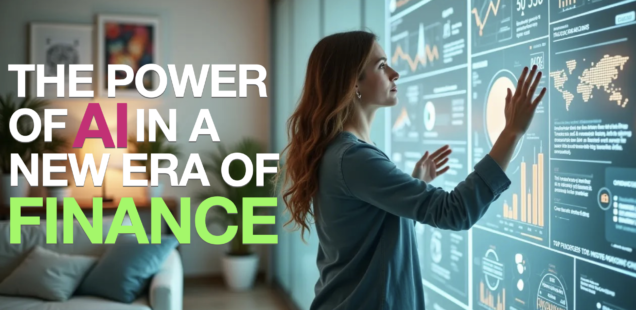
The Power of AI in a New Era of Finance
A few years ago I attended a workshop with a big consulting firm and a few banks and the working title was “THE FUTURE OF BANKING.”
We imagined how a personal financial advisor to clients would look like.
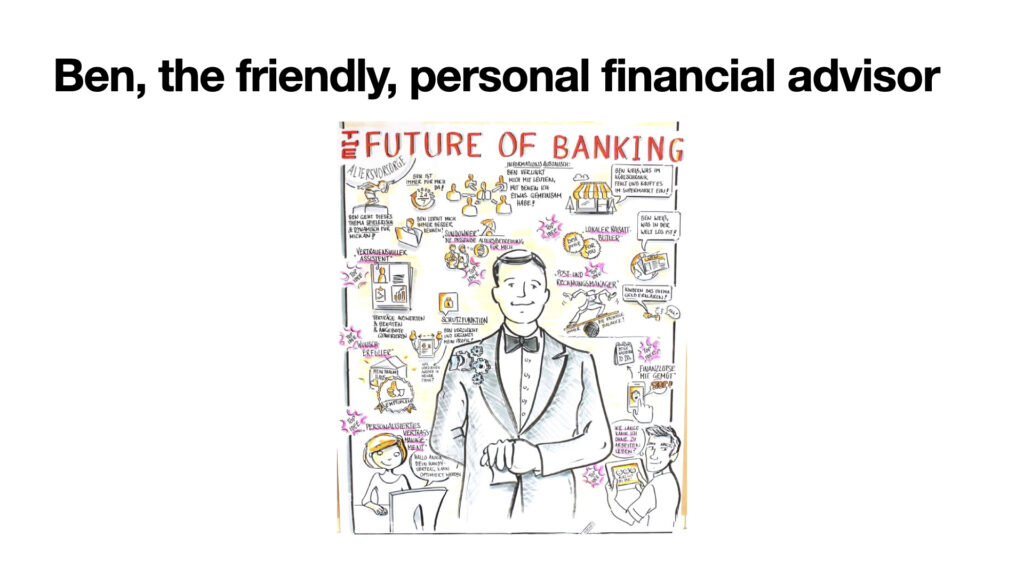
We came up with the picture of BEN, a butler or concierge who would manage all aspects of our financial lives. He would:
– Take care of our bills, invoices, and mail
– Lead us through all financial decision making
– Look after our contracts
– and much more
How would clients ideally interact with such an advisor?

At that time, we saw the first rise of chatbots, including those offered by banks.
However, they were quite limited in their capabilities.
Comparable to Siri, there wasn’t much you could do with them, and they lacked comprehensive knowledge about your financials and documents.
What we envision now is the ability to “interact with your virtual financial advisor”.
Why is it important for businesses and individuals to take control of their financial health?
– Inflation is eating your money,
– We need to increase our income or revenue,
– Investing in assets is a necessity,
– Better financial management is essential
Today’s Reality
– Banks offer basic digital services
– We have simple chatbots, they have world knowledge, but they don´t know about our financial situation
– Most people and businesses still struggle with financial management
– It’s time-consuming and complex.
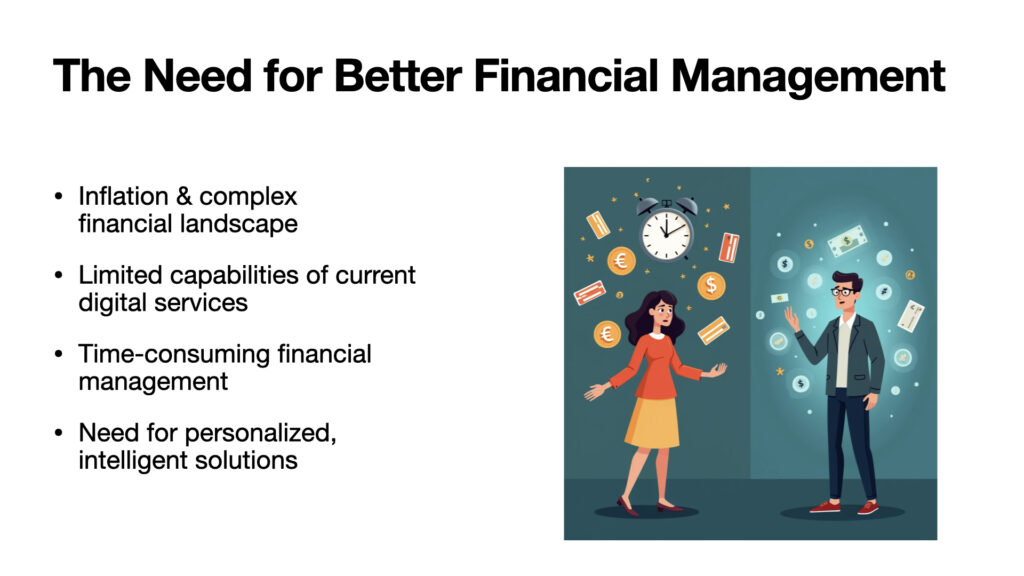
With the rise of LLMs (Large Language Models), this can be changed to the better.
LLMs are advanced AI systems that can understand and generate human-like text. They have been trained on vast amounts of data, allowing them to comprehend and respond to a wide range of topics, including financial matters.
– The AI can understand our bills, contracts, and assist with financial decisions
– It can comprehend the entire financial picture
– It´s always available
– It provides personalized advice
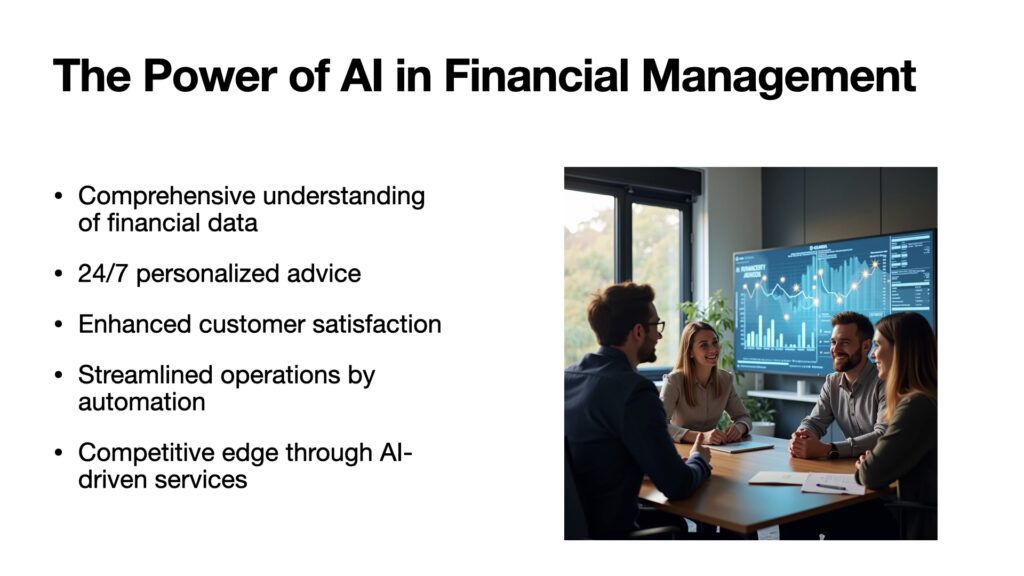
The power of AI and Large Language Models (LLMs) is changing financial management drastically.
For businesses, particularly in the financial sector, adopting these AI-driven tools can lead to significant advantages:
– Enhanced customer satisfaction through personalized insights
– Streamlined operations by automating complex financial tasks
– Ability to offer cutting-edge services that set you apart in a competitive market
By taking control of financial data and embracing these AI-powered tools, businesses can unlock a world of opportunities and improve their clients’ financial health. The era of interacting with virtual financial advisors is here, and it’s an exciting time to be part of this transformative journey.
But how do we get there? How to start taking control of your financial health?
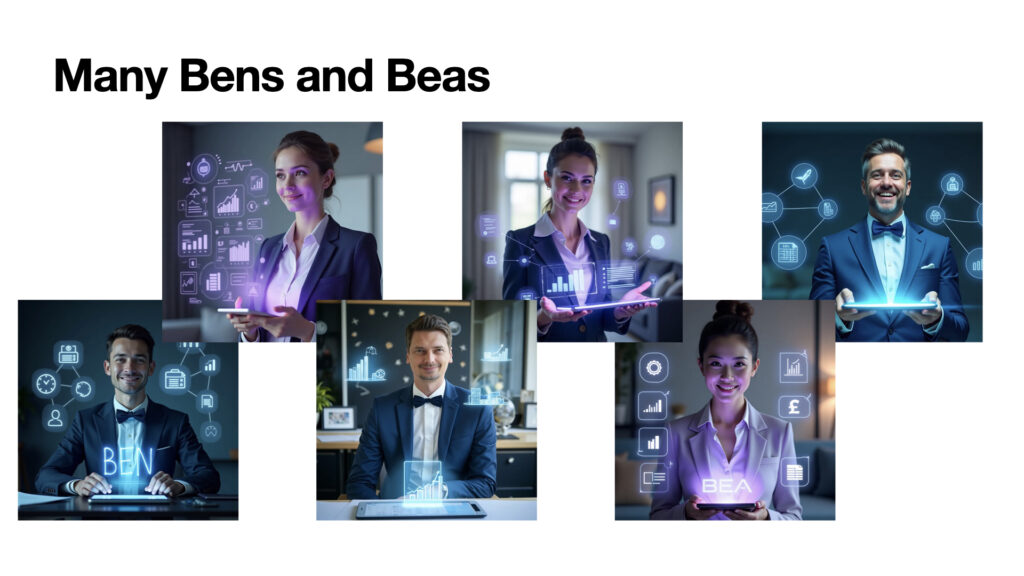
Each one of us could have his or her own Ben or Bea.
I invite you on a quick journey on how we can get there.
For the AI to know about our financial life, we need to feed it with data.
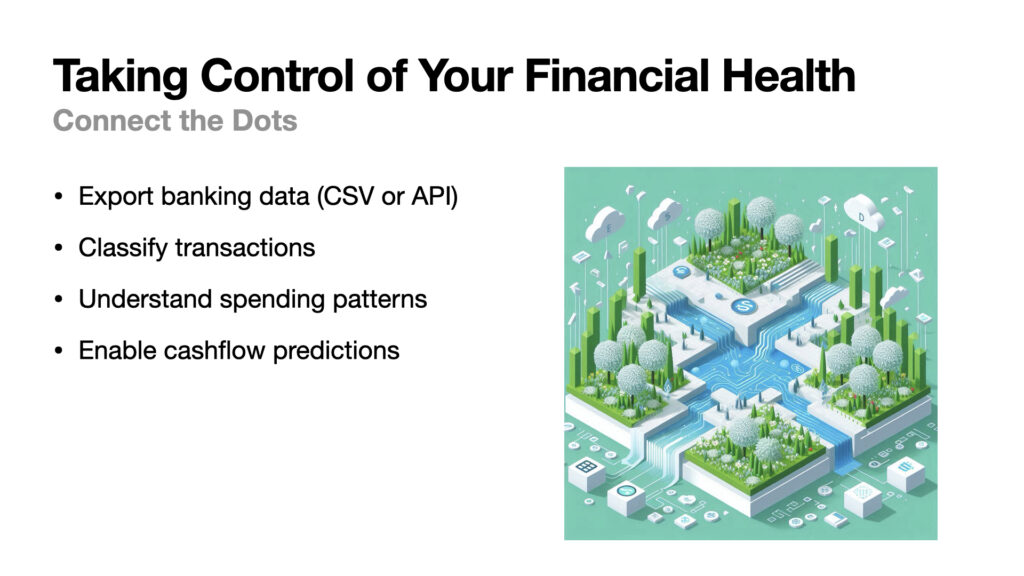
For that we need to export our banking data from our bank.
We can do that either with a CSV file download or banks also offer APIs, these are programming interfaces, to get a data feed of our transactions.
These APIs (Application Programming Interfaces) are a way for different software applications to communicate and exchange data with each other. In this context, banks offer APIs that allow you to securely access your financial data and integrate it with other tools or platforms.
Once we have our data we need to start classifying transactions.
Sort your spending into categories. This is key.
Why does it matter?
– It provides a clear picture of spending patterns
– It makes budgeting easier (helps identify areas of overspending)
– It enables personalized financial advice
For financial institutions and businesses, implementing these classification systems can greatly enhance their services. Banks can offer more detailed insights to their customers, while companies can better manage their finances and provide valuable analytics to their clients.
This process answers questions like “Where does all the money go? How many subscriptions does one have (Netflix, Disney+, ChatGPT, Amazon Prime)?” It reveals recurring spending (rent, insurance, electricity, etc.).
Cashflow Predictions
It also enables cashflow predictions once we know the monthly recurring income and spending.
– It determines the burn rate (how much cash is burned each month)
– It calculates the runway, which is especially important for creators, freelancers, solopreneurs, and small businesses
Stock Portfolio Analysis
Beyond basic transaction categorization and cash flow projections, AI can perform more complex financial analyses.
For instance, it can analyze stock portfolios, showing distribution across different industry sectors or world regions, and identifying imbalances. This capability allows for proactive risk management and ensures portfolios remain well-balanced and aligned with investment goals.
Imagine an AI agent constantly monitoring your portfolio, ready to alert you when adjustments might be beneficial.
The Big Picture
These processes form the foundation for AI-powered financial management. It’s how we move from basic banking apps to intelligent financial assistants.
Taking Control
By implementing this, businesses are taking the first step towards better financial health. You’re giving AI the information it needs to help you or your clients.
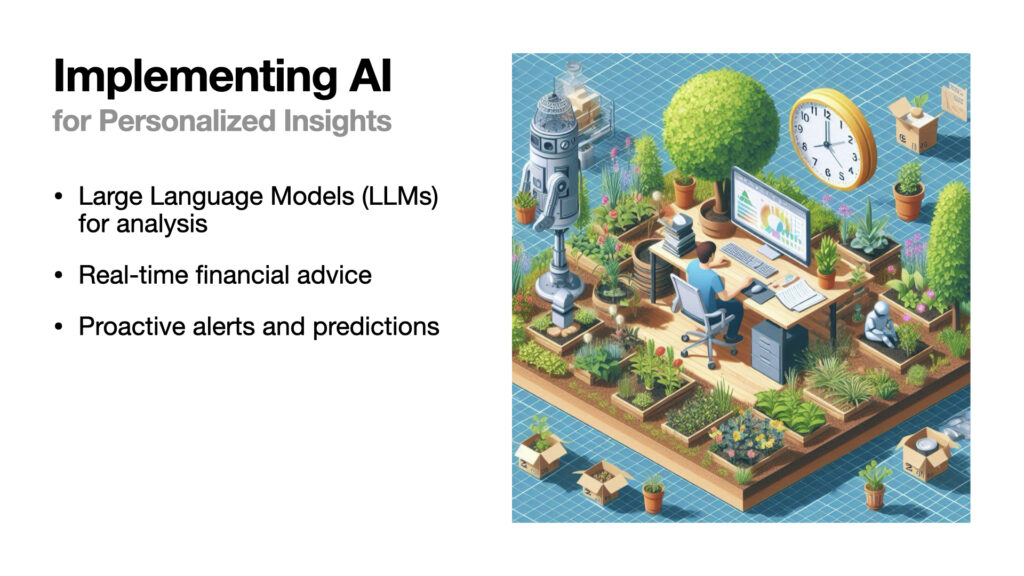
How can businesses best implement these systems?
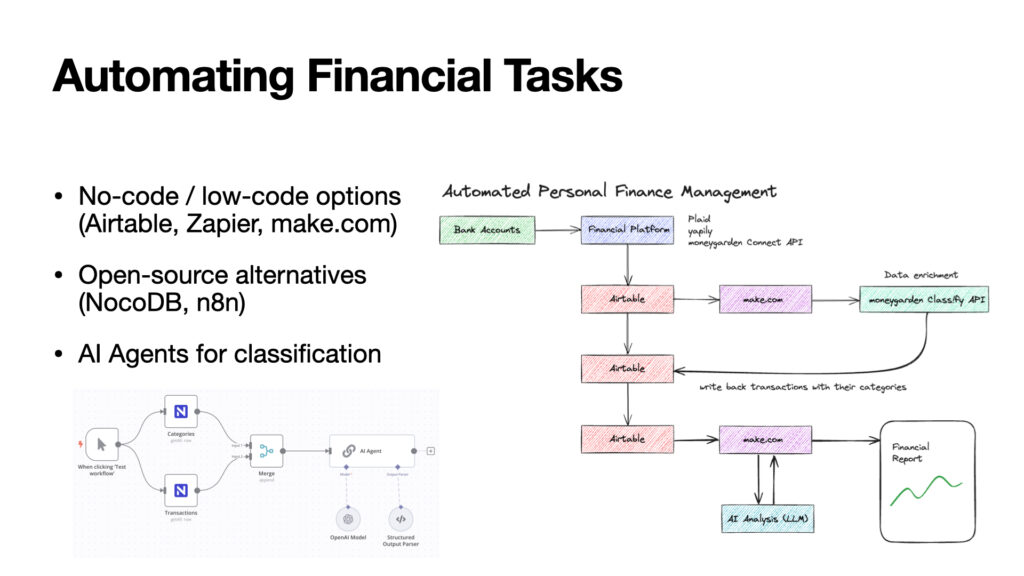
We see many no-code or low-code tools popping up left and right, there are commercial tools like Airtable for database storage (“spreadsheets on steroids”). This would be the place where we keep our transactions.
Then you will need a workflow processing tool, something like Zapier or make.com.
These tools allow the creation of workflows that take transactions, categorize them, and write the assigned category back to the database table.
Companies can use self-hosted versions of tools like NocoDB (similar to Airtable) and n8n (similar to make.com) to run these processes for their own business or their clients.
These are open source software, you can download them from the internet, install them on your laptop to try them out or install them on your own server or data center.
Once the workflow is set up to intake transactions, the next step is classification.
Businesses can either use a service like our moneygarden CLASS!FY API for this task, or they can implement it themselves.
This is where an AI Agent module or node is injected into the workflow.
This Agent can communicate with an LLM and handle the classification.
Right now you might be using ChatGPT, ask it a question or give it a task, this is called the prompt.
You define a prompt where you say: these are my 15 categories, you will now get this bunch of transactions, please assign each of them the corresponding category.
After that, the category for each transaction is written back to the database.
With some technical knowledge, but no programming skills, this is already possible using natural language.
The system can also be instructed to indicate its confidence level in each categorization.
Most of the time, it’s more than 90% confident, but sometimes the LLM isn’t entirely sure what a transaction text means, as they come from banks with sometimes unclear statements. In such cases, a more capable (though more expensive) model can be used for increased accuracy.
This can all be built into the workflow.
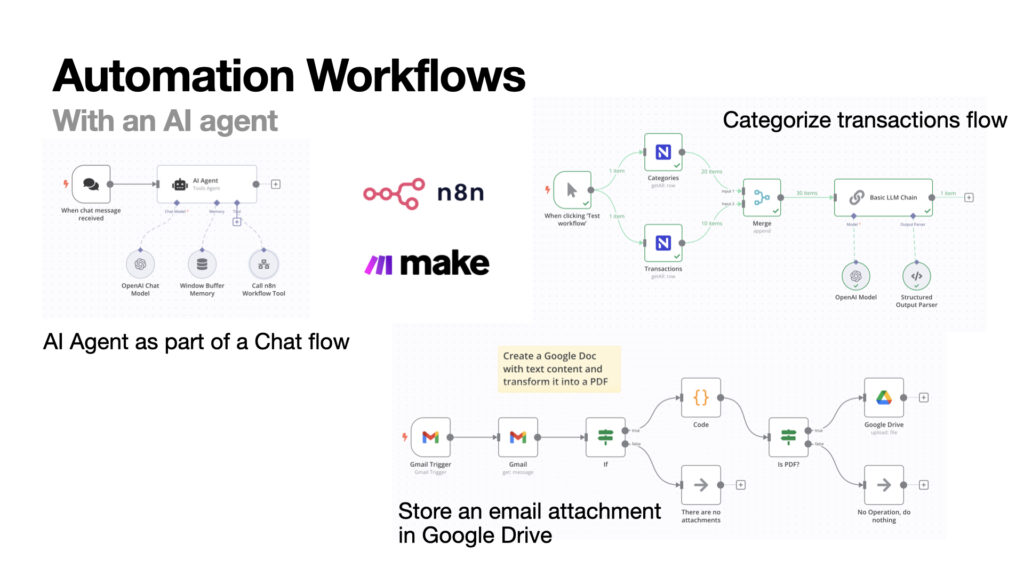
AI-powered systems turn raw data into valuable insights. This improves services and opens doors to advanced applications in finance.
Now, let’s see how adding document processing and chatbots can create a complete AI financial management system.
Documents
I collect documents like invoices and contracts, and store them in google drive.
I have a workflow where I send all my incoming invoices, bills and receipts to a specific email address. Then I have a listener on that. Whenever a new email with a document arrives, this will also be classified. The workflow extracts the text of the PDF, indexes the document and classifies it.
This allows for connecting transactions with invoices, which is incredibly useful. This requires some additional work, including the implementation of advanced search capabilities for semantic search.
To make this possible, we use a vector search database, that understands the context and meaning of the stored information. This allows users to find specific financial information quickly and easily, even when users don’t know the exact words or document titles they’re looking for.
Again, no programming skills are needed. It involves taking the text of a document, breaking it into paragraphs, and storing them in the database. It’s mainly a matter of configuring and connecting different modules in the workflow.
Now that we’ve explored how AI can process and analyze financial data, let’s look at how users can interact with this intelligent system. This is where chatbots come into play, serving as the user-friendly interface between people and the complex AI-powered financial management system.
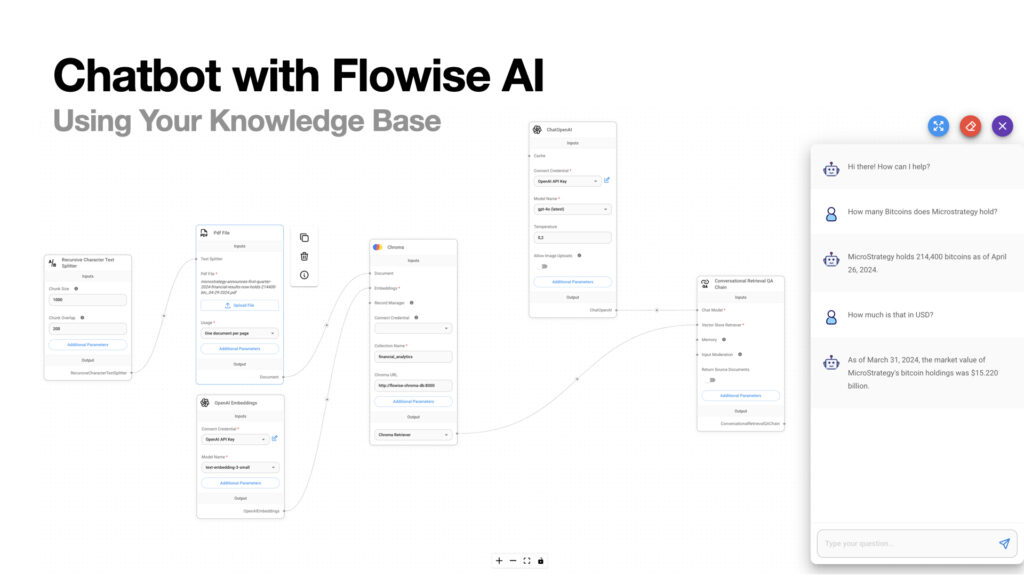
Let’s discuss the chatbot functionality.
There are two ways a chatbot can interact with the data:
1. The advanced search capabilities make it possible for the chatbot to access the data.
So when a user asks the chatbot “How much did I spend on doctor’s bills in the last 90 days?”, the search engine will be queried to find all relevant documents or transactions, and the AI or LLM will answer with this knowledge. This approach is called RAG (Retrieval-Augmented Generation).
2. AI Agents can be set up with knowledge of how to access the database. When a question is asked in the chatbot, the LLM will delegate the question to an agent, which will look in the database, retrieve the right transactions within a certain timeframe, and return the result. The chatbot will then reply with this contextual information.
So I can ask all kinds of questions like “tell me about our car insurances, how much do we pay, when is payment due? How much revenue did I do with my client XY?”
On this slide you see an example Chatflow that is built with FlowiseAI (YC S23).
Flowise is another open-source tool which I host on my own servers and you can do it too.
This chatbot can be integrated into a company intranet, your website (as a support chatbot), or CRM system.
Generative UI
Currently, most chat interactions are plain boring text. However, we´re now seeing UI elements like Charts and Documents Previews nicely integrated into the chat flow. We´ll see more of this for a more visual and engaging conversation with the virtual financial advisor.
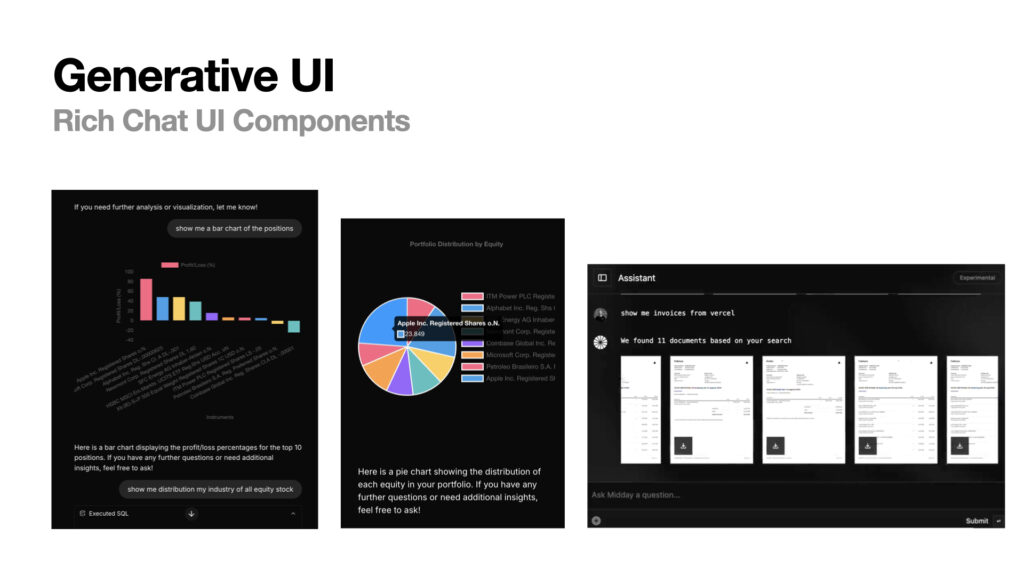
Additionally, speech-to-text and text-to-speech capabilities built into the chatbot interface will make it more like a natural conversation. Some thought or question comes up and users can ask the bot questions simply by speaking, truly enabling them to “interact with their virtual financial advisor”.
Implementation and Benefits
At moneygarden, we help businesses bring AI into their financial services.
Our CONNECT API securely links to banks, and our CLASS!FY API enables sophisticated transaction categorization.
I’d be happy to discuss how we can tailor these tools to fit your business needs.
When you use AI in your financial services, you can:
1. Make customers happier with personal, always-on financial advice
2. Work smarter by automating complex tasks
3. Manage risks better by constantly watching portfolios
4. Stand out from competitors with cutting-edge AI services
5. Understand financial data better to make smarter choices
I encourage you to take charge of your clients’ finances.
Start by extracting bank data, upload it into databases, experiment with automation tools, and implement AI agents where necessary. This opens up a world of opportunities, transforming raw data into actionable wisdom.
This vision is more achievable than ever before, and best of all, you don’t need to be a tech expert to build these kinds of AI-powered systems.
These systems are also more accessible than ever before. They provide valuable advice, helping both you and your clients.
Let’s talk about how we can help you bring AI into your business.
Enjoy the journey and the rest of the conference! Thank you for your time!
This article is based on the insights I shared during my recent talk at Seamless Europe, “The Power of AI in a New Era of Finance.” If you’re interested in watching the video, be sure to check out the full video recording.